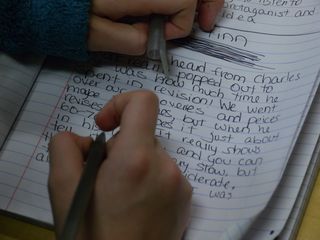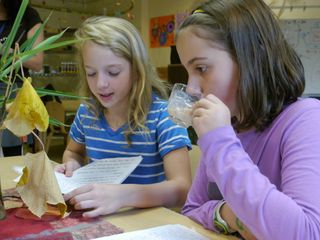Opening Doors

We've been thinking deeply about the role
of digital technology in learning at Opal School lately. How, we wonder, can we
embrace new media in a way that encourages the habits of mind that we are
trying to develop? How might digital technology support Opal School values?
How can it be used to foster connectedness? These discussions have
reflected both the great potential of new media tools as well as their limitations. How can we remain open to possibility while remaining vigilant
against the hazards (of isolation, of limitations, of a narrowing of wonder, curiosity, and imagination) that we fear?
The conversations have been provocative
and productive. Staff and parents have entered into dialog about hopes and
concerns. We're working through drafts of a statement that articulates our
current thoughts and questions about the topic, hoping that what we draft can support our emergent work
and be open to revision as we learn more.
At the same time, our use of technology is
opening doors. Next week at parent-teacher conferences, we'll bring parents
into our effort to use Evernote to enhance our student portfolio system. We
hope that using this multifaceted platform will develop reflectiveness and metacognition, make learning visible, and enhance school-home communication.
We're also
finding ways in which new media breaks down walls. I certainly saw an
example of that today, when Opal fifth graders spoke by Skype to Charles
Finn, an author whose essays have inspired their own (see earlier posts about this work here and here). Through that
conversation, children learned more about the writing process in a way that
validated their authority while catalyzing deeper inquiry.

A few representative reflections:
He uses the
same strategies we do!He revises the same piece of writing 40 or
50 times!I'm going to try to take my time with my
next draft.I love how he always writes down whatever
inspires him. I'm going to start bringing my songbook around with me so
if I come up with a awesome song I have my book right there.
Later in the day, students read their finished pieces to each other. These pieces were inspired by the structure of Finn's essays: The detailed, poetic description of setting and encounter with the unknown that led to personal epiphany. As they read, they inahabited the same space Finn had filled earlier in the day (albeit electronically.) As each student finished reading, just as many hands went up to offer compliments to their classmates as had been raised to ask questions of Finn. Here was an encounter where digital technology had served the goals, expectations, and values of the students and the school through personal connections.




I love that Charles Finn joined the author’s tea! An inspiring example of the potential of technology to support the work we’re doing.